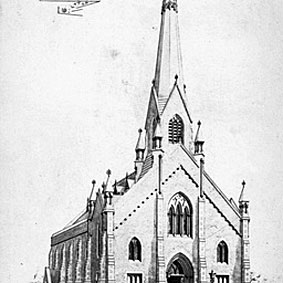
Draper Memorial Church, Adelaide
[Drawing by James Cumming
[State Library of South Australia (SRG 4/108/2/26)

Draper Memorial Church, Adelaide
[Drawing by James Cumming
[State Library of South Australia (SRG 4/108/2/26)
Historical and Technical Documentation by David Shield
© OHTA 2009, 2020 (last updated June 2020)
Constructed in 1867 as a Wesleyan Methodist Church to the south of the city centre, this church became known as the Draper Memorial Church, named after the Reverend Daniel James Draper, who was drowned when the London sank in 1866. With its Gothic spire, the church was designed by James Cumming, architect. Following a decline in membership, the church was sold in 1927 to an Apostolic denomination, and became known as the Apostolic Church. It was eventually demolished in 1971.1
First Organ.
The first organ in this church was built by Johann W. Wolff and was opened in 1874. This was Wolff's first two-manual organ.2 There were 12 stops, a Gothic case of stained pine with grouped gilt pipes, and it took eight months to construct, at a cost of £225.
The organ was described in detail on the occasion of the opening concert of sacred music on Friday 25 September 1874:
A selection of sacred music by the great masters will be given this evening in the Draper Memorial Church, Gilbert-street, upon the occasion of opening the fine new organ recently erected in that place of worship. The instrument, which we hare had an opportunity of inspecting, is a most perfect piece of colonial workmanship. The builder is G. [sic] W. Wolff, of Victoria-square, whose organs we have before favorably noticed. The following description of the instrument may be interesting:—lt possesses two manuals, CC to F, 54 notes, and 1-1/3 octave of pedals, and the following is the synopsis of stops:—Swell organ - Viol di gamba, 8 feet, 54 notes; salcional, 8 feet, 54 notes; principal, 4 feet, 54 notes; piccolo, 2 feet, 54 notes. Great organ—Open diapason, 8 feet, 54 notes; stop diapason, 8 feet, 54 notes; principal, 4 feet, 54 notes; twelfth (quint). 2-2/3 feet, 54 notes; fifteenth, 2 feet, 54 notes; flute, 4 feet, 42 notes; pedal organ, bassoon (reed), 8 feet, 13 notes; pedal organ, bourdon, 16 feet (tone), 17 notes.
Accessory movements —Two composition pedals to great organ. Couplers—Swell to great; great to pedals. The case is Gothic in design, of stained pine varnished, and, with its groups of gilt pipes, presents a very handsome appearance. The whole of the stops exhibit great care in voicing, and are full and clear, the swell organ being particularly effective; the soubass of the pedals is also very fine. The touch is light, and the wind supply (double action feeders) full and steady. Mr. Wolff is certainly to be commended for the finished manner in which he has turned out this organ, which we learn has only been eight months in construction. Its cost was £225. A good programme has been prepared by the Choir of the Church for this evening's concert in aid of the Organ Fund. Mr. Broadbent will preside at the organ. Mr. Sampson acting as conductor.3
Second Organ.
The Wolff organ was replaced in November 1908 by an instrument built by J.E. Dodd, using tubular-pneumatic action:
Draper Memorial Church was reopened with special services on Sunday after the renovations and alterations which have recently been carried out there. This church is connected with the Methodist Central Mission, under the supervision of The Rev. H. Howard, and was the cause of some anxiety a year ago owing to dwindling congregations. When the Rev. John Pearce took charge he was given a free hand to work out his ideas respecting the church music. Under his ministry the church has made gratifying progress, and with the installation of the new organ its future advance should be even more pronounced. The organ was built by Mr. J.E. Dodd on the latest and most approved system of tubular action, with all the modern accessories. It is of Gothic design, with a central tower and two flats of pipes. The woodwork of the case is of walnut dull polished. The cost of the organ was £245, and another £75 has been spent on the church renovation and in altering the choir gallery.4
The Dodd organ was iremoved in 1943 to the Congregational Church, Angaston.
___________________________________________________________
1 A.D. Hunt, This Side of Heaven (1985), p. 40.
2 David Shield, "Johann Wolff – South Australian Organbuilder," OHTA News, vol. 45, No. 2 (May 2020), pp. 11-19.
3 The South Australian Advertiser (25 September1874), p. 2.
4 Australian Christian Commonwealth (23 November 1908), p. 7.